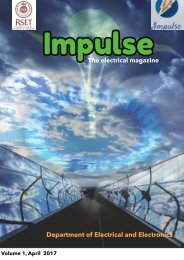combinepdf
Create successful ePaper yourself
Turn your PDF publications into a flip-book with our unique Google optimized e-Paper software.
ELECTRIC SPRING (ES)<br />
-a promising smart grid technology<br />
Ms. PRATHIBHA<br />
ASST.PROFESSOR, DEE<br />
Most PV systems are set<br />
up to disconnect from the<br />
grid whenever they detect<br />
a significant fault. If a<br />
single home’s PV system<br />
trips off-line, it’s<br />
only a headache<br />
for the owner.<br />
But if hundreds<br />
or thousands of<br />
t h e m d o s o<br />
simultaneously, it<br />
could upset the<br />
network’s<br />
delicate balance,<br />
t u r n i n g a n<br />
otherwise small<br />
disturbance into<br />
a n o u t a g e<br />
blacking out an<br />
entire city or county.<br />
Throughout much of the<br />
developed world, electric<br />
utilities are facing an<br />
unprecedented challenge.<br />
Growing numbers of<br />
customers are installing<br />
solar PV systems on their<br />
homes or businesses. The<br />
power they’re injecting<br />
into distribution lines is<br />
causing voltage- and<br />
frequency-control<br />
problems that threaten to<br />
destabilise the grid. While<br />
this is not yet a major<br />
problem, it could become<br />
one as distributed solar<br />
systems proliferate. The<br />
cause of the problem is<br />
the inverter, an electronic<br />
system that converts the<br />
d i r e c t c u r r e n t ( D C )<br />
supplied by the PV panels<br />
i n t o t h e a l t e r n a t i n g<br />
current (AC) that flows<br />
o n t h e p o w e r g r i d .<br />
Although they supply AC<br />
at the right voltage and<br />
frequency to sync with<br />
the distribution grid, they<br />
are otherwise passive.<br />
They can’t sense what is<br />
happening on the grid and<br />
adjust themselves<br />
accordingly. But newer<br />
“smart” inverters can<br />
prevent a PV system from<br />
going off-line when it<br />
doesn’t have to. By doing<br />
so, they can actually make<br />
the grid more stable, by<br />
preventing the sudden<br />
deterioration of voltage<br />
and frequency that would<br />
otherwise occur when<br />
hundreds or thousands of<br />
PV panels are suddenly<br />
taken off-line.<br />
Smart inverters are poised<br />
to fill a big need in the<br />
fast-evolving electricutility<br />
industry. As more<br />
and more homeowners<br />
put PV panels on their<br />
roofs, the power they are<br />
supplying is reducing the<br />
need for big, centralised<br />
generating plants. The<br />
upshot is that increasing<br />
n u m b e r s o f t h e s e<br />
traditional power plants<br />
are getting retired, and<br />
g r i d o p e r a t o r s a r e<br />
scrambling for ways to<br />
keep their networks<br />
running with the same<br />
high level of reliability<br />
that their customers have<br />
long taken for granted.<br />
The combination of smart<br />
inverters and new control<br />
methods will be essential<br />
for helping utilities<br />
transition to the grid of<br />
the future, in which vast<br />
amounts of wind- and<br />
solar-generated electricity<br />
will be the norm. A smart<br />
i n v e r t e r c a n “ r i d e<br />
through” voltage or<br />
frequency dips and other<br />
s h o r t - t e r m g r i d<br />
disturbances and if these<br />
inverters have<br />
communications<br />
capabilities, they can let<br />
grid operators monitor




